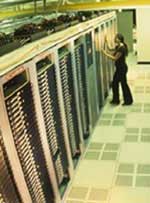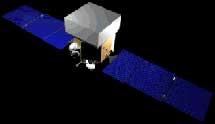

Thursday – March 2, 2006
 |
 |
|
Thursday – March 2, 2006 |

Image by Peter Ginter PetaCache: Use That MemoryFor decades, high energy experimental physicists have struggled with a fundamental problem: they simply have too much data to analyze quickly and in its entirety. BaBar researchers routinely wait nine months for computers to sift through large datasets, searching for interesting events and setting these aside for later analysis. This “data skimming” alone constantly uses about 50 percent of BaBar's computing power. And that’s before a researcher can even start analyzing his or her data. Preparing data from CERN's Large Hadron Collider (LHC) will only take longer. Recognizing this widespread limitation, a team at SLAC is developing the PetaCache project, a new way of thinking about data access and storage. With new computer software and more efficient types of memory, PetaCache may significantly increase the speed of data analysis. “PetaCache may help scientists change the way they think about exploring new ideas,” said PetaCache project manager Randal Melen. “It will allow a physicist with a sudden new idea, an ‘I wonder if…’ moment, to quickly begin exploring that new idea.” Read more... |
||||||||||||||||||||||||||
|
|
||||||||||||||||||||||||||
 SSRL Result:
|
DC2 Seeks the Secrets of the Gamma-ray Sky
Gamma rays will reveal many secrets of the universe—but not until we know how to read their signals. Launching this week at SLAC is the GLAST Data Challenge 2 (DC2), a months-long “roleplay” of how physicists will analyze data coming from the Gamma-ray Large Area Space Telescope when it goes into orbit in 2007. DC2 follows an earlier, more rudimentary version of the challenge held from December 2003 to February 2004. For the challenge, the organizing team members have secretly hidden a variety of astronomical objects in a computer-simulated mock universe, very similar to our own. They then calculated what that galactic center would look like to GLAST’s telescopes and created large data files to simulate the observations that will be beamed back to Earth from the satellite. DC2 members take the enormous quantity of simulated data, representing 55 days’ worth of observation, and try to determine as much as possible about the mock universe. They will use the exercise to refine their analysis tools and techniques. Read more... |
Events (see all | submit)
Announcements
|
||||||||||||||||||||||||
| | ||||||||||||||||||||||||||
What's Cookin' at the Linear Cafe (see weekly menu)
|
||||||||||||||||||||||||||
|
|
||||||||||||||||||||||||||
 <%
Response.AddHeader "Last-modified", getArticleDate()
'Response.AddHeader "Last-modified","Mon, 01 Sep 1997 01:03:33 GMT"
'Monday, December 06, 2010
%>
<%
Response.AddHeader "Last-modified", getArticleDate()
'Response.AddHeader "Last-modified","Mon, 01 Sep 1997 01:03:33 GMT"
'Monday, December 06, 2010
%>View online at http://today.slac.stanford.edu/. |
||||||||||||||||||||||||||